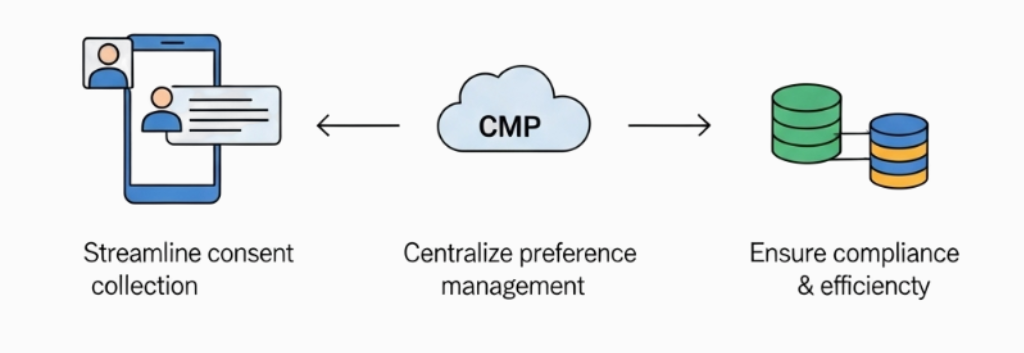How can marketers personalise experiences in a privacy-first world without relying on invasive tracking? As privacy regulations tighten and consumer expectations shift, the old playbook of third-party data is quickly becoming obsolete. So what’s next for digital marketing?
Zero-party data offers a direct, ethical, and highly effective solution. It empowers businesses to understand customer intent without crossing boundaries, turning declared preferences into profit. But to make this work, marketers must rethink how they collect and activate data, starting with consent.
In this blog, we’ll explore what zero-party data really means, how it differs from other types of customer data, and how businesses can turn consent into conversion with the right strategy.
Zero-party data is information a customer intentionally and proactively shares with a brand. It includes preferences, purchase intentions, communication choices, and personal context.
This type of data is incredibly valuable because it’s explicit—marketers don’t have to infer anything. It gives businesses a precise understanding of what users want, how they want it, and when.
Zero-party data can take many forms depending on the interaction context and the platform’s intent to personalise experiences.
These examples show that zero-party data is all about volunteered insight, valuable and reliable when handled correctly.
Understanding how zero-party data fits within the broader data landscape is key to structuring a compliant and high-performing marketing stack.
Customer data is typically divided into four main types: zero-party, first-party, second-party, and third-party data. Each plays a distinct role in how businesses understand and engage their audiences across digital platforms.
First-party data is gathered directly from users based on interactions with your website or app, such as clicks, purchases, or browsing history. Second-party data is essentially someone else’s first-party data, shared through a partnership. Third-party data, however, is collected by outside providers from multiple sources, often purchased in bulk. These include ad networks, data brokers, and tracking tools, and it tends to be broad, impersonal, and less reliable.
In contrast, zero-party data is volunteered directly by users, not inferred or tracked. This makes it more accurate, consent-based, and compliant, especially vital in an era of tightening privacy laws and shifting consumer expectations.
With tightening regulations and growing digital literacy, users are increasingly cautious about how their data is collected and used. However, when brands are transparent and communicate the value exchange clearly, users become more inclined to share their preferences.
This shift in behaviour makes zero-party data not only more accurate but also inherently privacy-compliant. It reflects a conscious decision by the user, leading to better data quality and stronger brand-consumer relationships.
Since zero-party data is shared intentionally and knowingly, it aligns naturally with consent-driven frameworks like GDPR and CCPA. This reduces legal ambiguity and enhances targeting accuracy; marketers can finally rely on data that is both reliable and ethical.
According to a 2024 Cisco survey, 81% of consumers consider data privacy a key buying factor. This shift makes zero-party data more than just a compliance tactic—it’s a strategic advantage. To succeed, businesses must design clear, user-friendly processes that gather preferences early and use them effectively throughout the customer journey.
Today’s marketers face more than just creative pressure—they need technical precision, regulatory compliance, and scalable strategies to retain customer engagement.
Regulators in the US, UK, and EU have made user consent non-negotiable. With the California Privacy Rights Act (CPRA) and the UK’s Data Protection and Digital Information Bill taking shape, the era of passive data collection is over.
Consent must be active, clear, and documented. Zero-party data simplifies compliance by being self-declared and transparent.
Zero-party data enables brands to design marketing based on what users want, not what marketers guess. This improves:
In future, consumers will stop buying from brands delivering unpersonalised experiences. The payoff is real and measurable.
Most of the consumers expect brands to protect their data and use it responsibly. Zero-party data answers that expectation. When brands ask instead of assume, trust builds organically.
Turning consent into profit begins with strategic infrastructure—designed not just for compliance, but for meaningful user interaction and long-term value creation.

Users need a reason to share their preferences. Smart businesses create incentives:
These don’t just collect zero-party data—they build user engagement while doing so.
User consent must precede any form of data collection. It should be as frictionless as possible while remaining compliant. Businesses should avoid complex cookie banners or vague opt-ins.
Once collected, this data should directly impact decisions. Use it to:
Zero-party data enables businesses to stop guessing and start aligning with real preferences.
Manual consent management is prone to error and non-compliance. Automated consent management platforms (CMPs) like Seers AI streamline the entire lifecycle:
With such platforms, businesses can scale zero-party data strategies responsibly and legally.
As data preferences evolve, marketers must balance ethical collection with operational effectiveness to ensure sustainability and trust in every customer interaction.
Zero-party data must remain relevant. Businesses should offer users control over their preferences and allow them to update, modify, or withdraw consent easily.
Use progressive profiling—collect only what’s needed upfront and expand gradually based on engagement.
Complex forms lead to abandonment. Instead, embed data collection within natural interactions. For example:
Make every interaction a potential consent touchpoint.
Collected data should sync with your CDP, CRM, or analytics platform. It must be stored securely, encrypted, and access-controlled.
Compliance isn’t just about collection—it’s about end-to-end handling of consent data.
Adopting zero-party data isn’t without friction. But with the right systems and mindset, businesses can overcome limitations that typically derail privacy-first initiatives.
Too many prompts can overwhelm users. Use context-based timing to ask for information only when necessary. Gamify experiences to make sharing more engaging.
Zero-party data is valuable but can age quickly. Set refresh cycles. For example, prompt users every six months to revisit preferences, especially for seasonal products or changing trends.
Different regions have different standards. A GDPR-compliant consent model might not meet CCPA requirements.
CMPs like Seers AI handle geo-targeted consent experiences, ensuring compliance in multiple territories without extra developer effort.
Zero-party data has moved from being a trend to a standard in today’s privacy-first marketing environment. As users demand more transparency, brands are expected to collect data in a way that feels respectful and intentional.
To maximise value, businesses must go beyond surface-level consent, offering users control, context, and meaningful engagement. Declared preferences should directly inform marketing decisions, from product recommendations to communication styles.
When applied effectively, zero-party data transforms consent into a strategic asset, powering relevance, loyalty, and long-term customer relationships without compromising trust.
Unlock the full power of zero-party data—ethically and effortlessly. Seers AI helps your business stay ahead of privacy trends while delivering hyper-personalised experiences that users trust. From real-time consent collection to preference syncing, it’s built to turn every interaction into an opportunity for growth.
To collect zero-party data legally, always obtain explicit consent. Clearly state what data is being requested and why. Use opt-in forms, explain how the information will be used, and let users control their preferences. Align every step with privacy laws like GDPR or CCPA to build trust and avoid penalties while collecting meaningful, user-declared data.
Zero-party data can be collected at scale through preference centres, interactive quizzes, onboarding surveys, and account settings. Embed these touchpoints across your website, app, and emails. Automating collection via CRMs and integrated forms helps large businesses gather and organise responses efficiently. Focus on relevance and timing to encourage users to share information willingly.
Zero-party data is more accurate because it’s shared directly by users, based on their preferences and intent. Third-party data, in contrast, is often purchased or inferred, lacks context, and may be outdated or non-compliant. With growing privacy regulations and cookie deprecation, marketers benefit more from declared, permission-based data than from unreliable third-party sources.
Zero-party data should be refreshed every 6–12 months, depending on your business cycle. User preferences can change with seasons, product availability, or personal needs. Regularly updating the data ensures continued relevance and personalisation. Trigger updates during major interactions—like purchases, renewals, or email re-engagement campaigns—to keep your marketing strategy aligned with customer intent.
Yes, zero-party data significantly improves email marketing. When users share their content preferences, frequency choices, or interests, your emails become more relevant. This boosts open rates, click-throughs, and conversions. By relying on declared data, you also reduce unsubscribe rates and increase engagement, making your campaigns more targeted and aligned with each user’s expectations.
Useful zero-party data comes from questions that reveal preferences, needs, and intentions. Ask users about their favourite product categories, communication preferences, challenges they face, or desired features. Keep questions simple, relevant, and actionable. Use drop-downs, sliders, or multiple-choice formats to make participation easy and the data collected clear and structured.
 Rimsha Zafar
Rimsha ZafarRimsha is a Senior Content Writer at Seers AI with over 5 years of experience in advanced technologies and AI-driven tools. Her expertise as a research analyst shapes clear, thoughtful insights into responsible data use, trust, and future-facing technologies.


United Kingdom
24 Holborn Viaduct
London, EC1A 2BN
Get our monthly newsletter with insightful blogs and industry news
By clicking “Subcribe” I agree Terms and Conditions

Seers Group © 2025 All Rights Reserved
Terms of use | Privacy policy | Cookie Policy | Sitemap | Do Not Sell or Share My Personal Information.